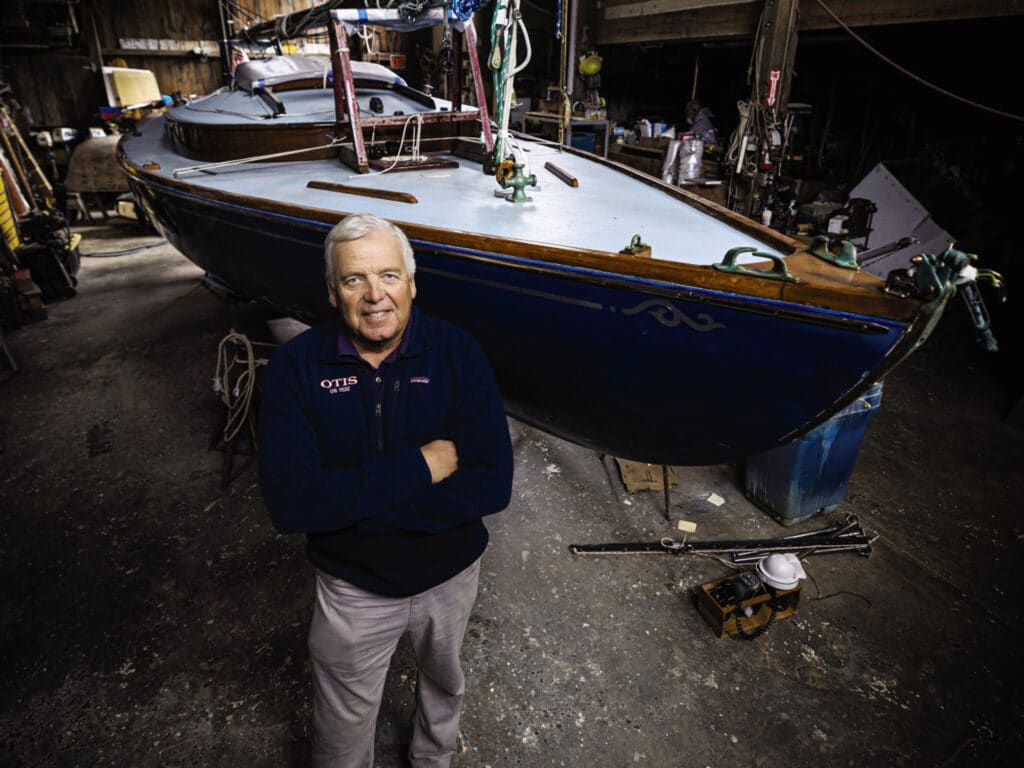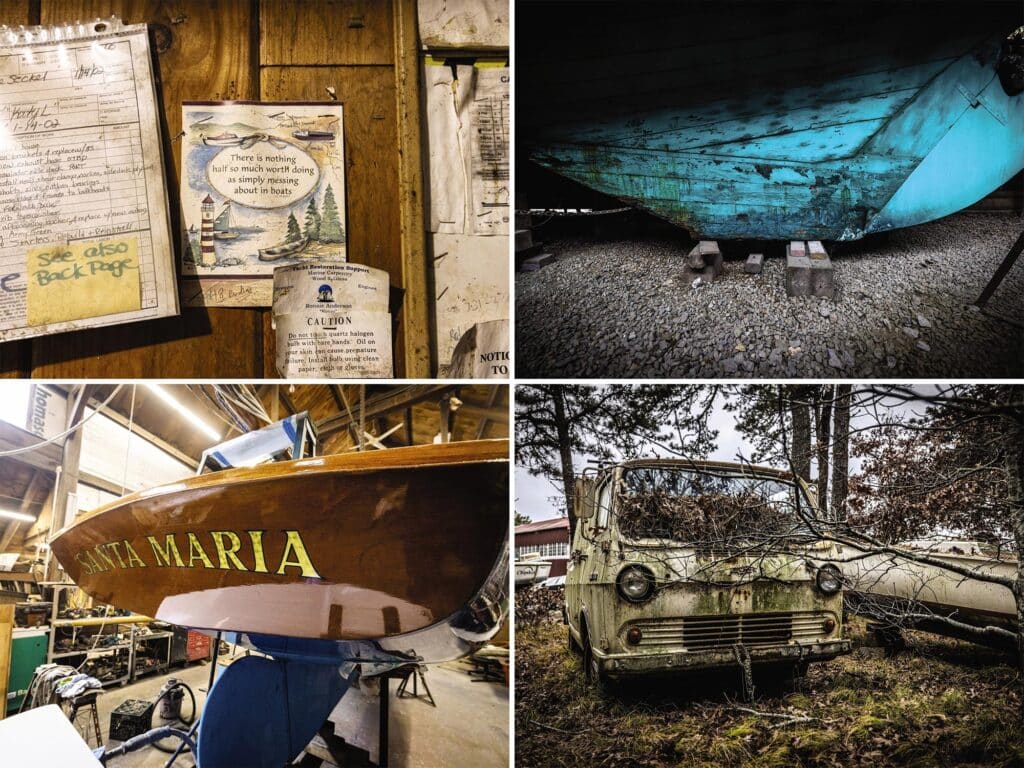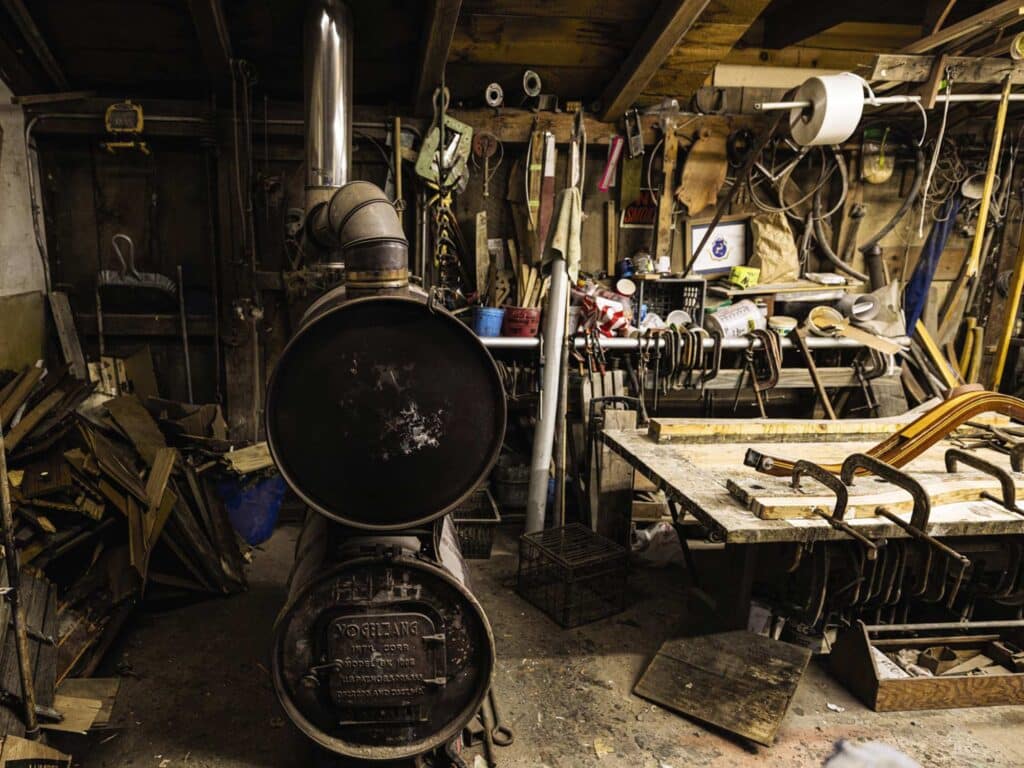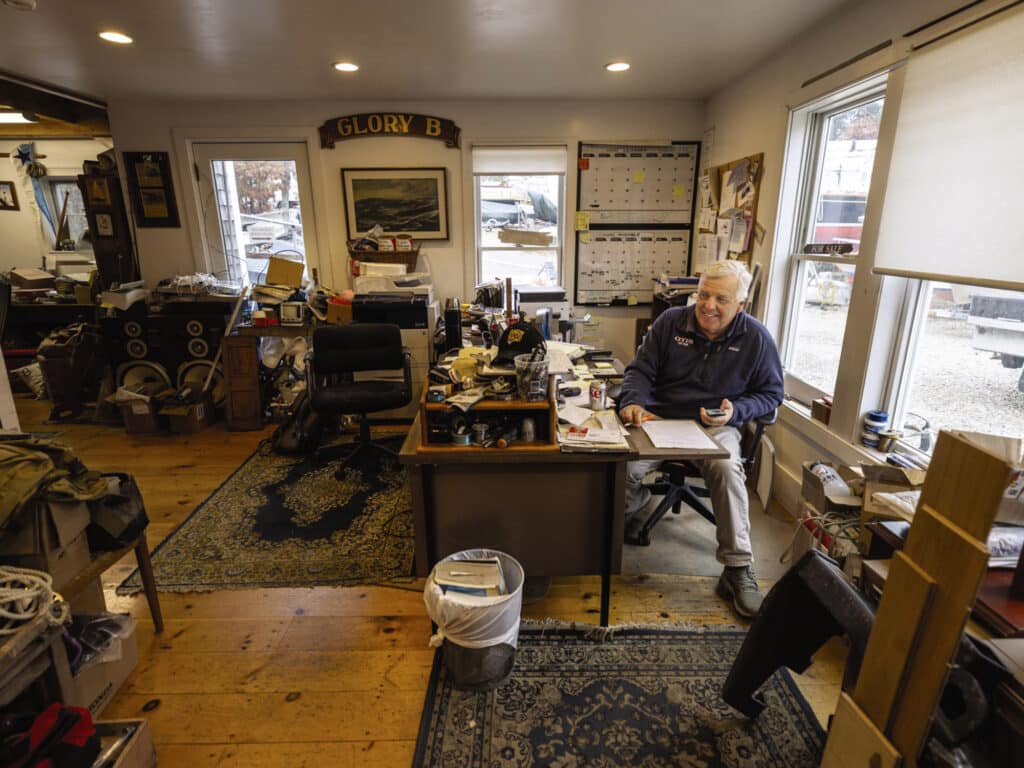
Karl Anderson is working in his shop when he stops to answer what should be a straightforward question: How many boats do you own? After a lengthy pause, the 64-year-old responds, “I don’t even know.” Yet the answer can be found with a thorough inspection of the grounds outside the door of Karl’s Boat Shop in Harwich, Massachusetts. What a passing motorist on Great Western Road might assume is just another Cape Cod nautical junkyard has an eclectic collection of vessels ranging from beautifully maintained racers to unfinished projects. Anderson owns a lot of them—some by choice, a few by trade, but most by chance or unpaid invoices.
When I pay him a visit, and our discussion turns to an obscure design by Ray Hunt, Anderson perks up. “I have one of those in the woods out back,” he says. “You can have it if you want it.”
This is not an attempt to bribe a reporter into writing a more favorable story, just a fact that it is there for the taking.
One reason Anderson has so many boats in his possession is because he has always had a fondness for things that float (or should float). He learned to sail on the waters of Cape Cod in general and Dennis in particular, first in Turnabouts and then in O’Day Widgeons. His first Rhodes 18 was a boat that had washed up on shore, upside down with the centerboard stuck in it.

In 1973, Anderson begged his mother for the $800 to buy it, and an older sailor advised him on how to restore it. He started sailing with his friends Chris Cooney and Wick Shepherdson. Four years later, Anderson had sorted the boat and made a name for himself in the class. At the helm of his parents’ Ford LTD station wagon, a water buffalo of a tow vehicle, Anderson and his crew drove north to Biddeford, Maine, for the Rhodes 18 Nationals. Before the team entered the tunnel in Boston, Anderson looked up and noticed his father, who turns 100 this year, waving from a bridge above. The drive home was a fun one, as the team won the national title.
A love of sailing motivated Anderson to open his boat-repair shop in 1983. The firm’s philosophy is summarized in five words: “Have fun working on boats.” And work on them he does. But first, he sails on many of them so he can develop a feel for what they need. One case in point is the J/24. Way back, Anderson started out sailing with sailmaker Dan Neri on his J/24 in Newport and then jumped into a boat with Ken Read. Back in the 1980s, brand-new J/24s needed substantial modifications to be optimized, and he was the guy to do it.
Anderson’s philosophy of boat preparation is the same today. “My method is the blades first. You make the blades the best,” Anderson says. “Secondly, make sure the rig is aligned with the blades, centered side to side. If the rig can’t be centered side to side, what’s the best compromise? Then the bottom. I might even go rigging, ease of use, then the bottom after that because if you can’t tack the boat, it doesn’t matter how good the bottom is.”
Read, now president of North Sails, is a busy man but eager to make time to talk about his boatwright of choice. He quips, “Is this for an article…or a book?”
They started sailing together in the late 1980s and have a lot of time on the water. Read credits Anderson as a critical factor in what he describes as a division of responsibilities.
“Karl was in charge of the boat from the waterline down. Someone else was in charge of the waterline up. I was in charge of the sails. Moose [McClintock] was in charge of the safety gear.”

It was a different era. Professional sailors didn’t get paid to sail. They all had jobs, and if they sailed well and won regattas, it boosted their businesses. Anderson worked on boats. Read sold sails, and success on the racecourse was good business. And they still had fun. At the J/24 North Americans in San Francisco, for example, the team could work late into the night to prepare the charter boat. Or they could get most of the work done, knock off early and attend a Grateful Dead show. The vote was unanimous, and Read, Anderson and the rest of the crew saw the Dead in their natural habitat.
After more victories in the J/24 and Etchells than he can recall, Read is quick to credit Anderson. “Karl has a lot of talent and not a lot of ego. I think it comes from a blue-collar mentality. Whenever he introduced himself, he would say, ‘Karl Anderson, Karl’s Boat Shop, Karl with a K.’ He doesn’t mind getting dirty. Anybody who knows how to use tools and doesn’t mind fairing the damn keel himself is naturally going to have less of an ego. It’s work ethic, family, surroundings, what he does for a living. It’s never pretty with Karl, but it somehow works. If you said to him that the bottom needs to be perfect, it was perfect, exactly to the tolerances you were looking for. He doesn’t do things conventionally, but he always does things right. The guy just wins.”
McClintock has sailed with Read and Anderson a fair bit too and says, “Sailing is a sport where you have to earn your respect, and Karl’s earned it with everybody.”
Part of Anderson’s reputation is his demeanor. McClintock says he’s never seen Anderson angry. He’s also quick to note that he’s a great athlete. “He looks like a dumpy guy, but he’s not. He’s quick, he’s agile, he can ski, he can play hockey, and he’s one of the best technical crews you’ll ever see. I learn from him every time I sail with him. He’s really good at making boats go fast.”
While Read is a well-known sailor around the globe, he is not the most famous customer of Karl’s Boat Shop—not by a long shot. That honor belongs to the late, great Sen. Edward Kennedy. For a decade and a half, the senator entrusted Anderson with the care of his beloved Ray Hunt-designed 50-foot Concordia schooner Mya.
Anderson went sailing with Kennedy on numerous occasions. With a grin, he recalls being out on Mya for a sail and saying, “Senator, there are rocks over there.” To which the senator replied, “I’ve been sailing these waters for 50 years; there are no rocks there!”
About two minutes later, the boat stopped—abruptly.
Anderson and his colleague John Sheehan made news when they lost control of Mya during a delivery at the end of the season and put the boat aground in the soft sand of Cold Storage Beach in East Dennis. The famous vessel was later pulled to safety by a tugboat. The damage was minor.
Many sailors on Cape Cod are summer people, so when the crocus and daffodils are popping through the underbrush, so too is the pace at the cluttered boat shop. “We have a very seasonal group that comes here for the summer. They race the local boats, such as the Wianno Seniors,” Anderson says. “They come the first week of June, and then they’re gone the week after Labor Day. They have a certain amount of time, and they don’t want to miss anything, so if something breaks, they want it fixed yesterday.”
Few people in the boat-restoration business are fortunate enough to have created an iconic product that is an embodiment of who they are. The Karl’s Boat Shop tiller is a thing of beauty, a shape that can be identified from afar. In keeping with the philosophy of the shop, the tiller wasn’t a creation based on divine inspiration. It was a sublime answer to a practical problem.
A sailor by the name of Rick Bishop didn’t like the feeling of the stock, straight J/24 tiller hitting him in the back of the legs. Anderson thought about it for a bit and created a design with a distinctive bend.
At the time, his shop was laminating ribs for a boat. Anderson gathered up the scraps and fabricated the first of his iconic tillers. “They were made from quarter-inch strips,” he says. “We always said it was mahogany, but it’s really red cedar. That’s how we got them so light. If you don’t varnish them, they will go 10 years. Some guys have them for 20 years. Each tiller receives two coats of sealer, three coats of varnish. The varnish of choice is Epifanes.”
Two of Anderson’s tillers, one for a J/22 and another for a J/24, are mounted on the wall of professional sailor Chris Larson’s home because of the wars they have been through and the great memories they recall. After Read moved on to other classes, Larson inherited Anderson and went on to win the J/24 Worlds with him in 1996.

Larson is quick to corroborate Anderson’s meticulous boat preparation. “Karl was always the master of figuring out what to do next with boat optimization. Once you got the boat back from him, you were confident that it was sorted. You had to have good boat mechanics, get a good start, and if all of that worked out, you were going to have a good event.”
Larson adds that Anderson is the kind of guy who simply gets the job done. “It doesn’t matter what you have to do,” Larson says. “His wasn’t a shop where everything was pretty. It was a get-it-done approach. That’s just how Karl operates. He was always one of those larger-than-life guys, always part of the team. Everybody in the boat park knows Karl. He has a personality that everyone likes and respects. He’s the good part of sailing, the nostalgic history of the evolution of certain classes. In the J/24, he was in the middle of it all, and it would not have been the same without him.”
Professional sailors are not the only customers Anderson caters to. Mark Hillman is a highly accomplished Corinthian competitor who has owned a fleet of racing boats, including five J/24s and a J/70. When Anderson was working on his J/24 (No. 196 named Dr. Feelgood), he arrived to find there were still some details that needed tending to. “We enjoyed a vacation in Chatham while we waited for the boat to be ready,” Hillman says. It was worth the wait; Hillman would later finish third in the J/24 World Championship and win the East Coasts.
A lot of boat shops have come and gone since 1983, but what has kept the doors open at Anderson’s place makes complete sense. “Stay away from building boats,” Anderson says, looking up from an invoice on his cluttered desk. He has built a few custom boats and restored countless yachts, but he has never been lured into the production boatbuilding business. It’s too volatile. Instead, seasonal work, hauling and storage keep the lights on. The race-boat stuff is a passion. Then there are the friends who show up with interesting projects.
Anderson has been in the business long enough that some of the boats he has restored over the years are ready for a second restoration. One he’s trying to get back on the water is Wizard, an aptly named 40-foot 1959 Concordia yawl designed by Ray Hunt, which is hibernating in a well-loved boat barn toward the back of Anderson’s property. If he can convince one or two partners to join him, and find the time between a busy race schedule and running the shop, Wizard will set sail again on Cape Cod—someday.
Wizard is a big project, one that will consume a substantial amount of time, talent and money. But with a twinkle in his eyes, Anderson says he’s bought plenty of things he couldn’t afford over the years, but somehow he found a way to pay for them. Sweat equity is how, and at Karl’s Boat Shop, there’s plenty of it. The work is dirty. And it’s messy. But the result is always fast.









